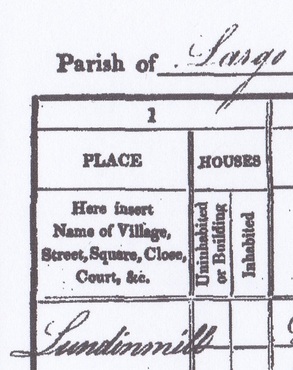
There were around 2,500 individuals in the Largo Parish in 1841. Within that total, 499 were recorded in Lundinmill (in 82 houses), 156 in Drummochy (in 22 houses), 395 in Kirkton of Largo (in 81 houses), 109 at Temple (in 21 houses), and 76 in the 'country' (in 13 houses). The remaining people were recorded as living in 'Largo'. Overwhelmingly, the answer to the question about whether you were born in the county was 'yes'. Among the handful of people who answered 'no' were the Dand family. David Dand was the manager of the Spinning Mill at Largo. He, his wife and four children had been born elsewhere in Scotland.
Only a very small proportion of the population were over the age of 70. Considering this was a time before the arrival of the railway and all the opportunities that it brought, traditional occupations feature heavily. Lundinmill mainly had a population of hand loom weavers, as well as a fair few agricultural labourers and a handful of specialist occupations such as tailor, milliner, baker, shoemaker, miller, mason, teacher, toll keeper and road surveyor. The Temple was also mainly a settlement of weavers but with a few fisherman thrown in. Largo was only slightly more diverse - with most people still connected to the linen trade, either as hand loom weavers, flax dressers or flax spinners. Other occupations included agricultural labourers, wrights, shoemakers, engineers, publicans, stone masons, servants and of course several fisherman. A significant number of people were described as 'paupers'.
Over the next few posts, the local hand loom weavers will be looked at in more detail. The growing of flax by farmers in the area, made the manufacturing of linen the parish's main industry, employing much of the local population.
 RSS Feed
RSS Feed
